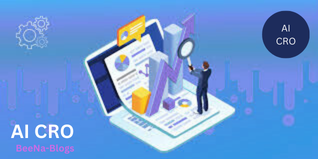
In the ever-evolving digital landscape, AI Conversion Rate Optimization (AI CRO) has emerged as a game changing strategy for businesses looking to turn website visitors into paying customers or engaged users.
For businesses and digital marketing agency, knowing how Artificial Intelligence (AI) can transform your Conversion Rate Optimization (CRO) strategies is important to staying competitive in the marketplace.
As per we all know, CRO has been a marketing staple for a decades and by this method marketing agencies no doubt got dreamed success in this field. However, AI-driven systems can process vast amounts of data instantly, with offering new level of personalization, scaling and automation. AI CRO is a smatter method to turn visitors customers into loyal customers.
Let’s explore in this blog what is AI CRO and how AI is transforming Conversion Rate Optimization strategies:
What is AI Conversion Rate Optimization (CRO)?
AI CRO is the use of artificial intelligence to improve how effectively a website or digital platform turns visitors into customers or leads. Unlike traditional CRO, which relies on manual testing and historical dads, AI CRO uses machine learning algorithms to study real-time user behavior-such as clicks scrolling patterns and time spent on pages-to make intelligent decisions on the fly.
AI doesn’t just analyze data, it predicts what users are likely to do next and proactively changes elements on the page to guide the, toward a conversion.
How AI Increase Conversion Rate Optimization?
Here’s a detailed breakdown of how AI increases conversion rate optimization (CRP):
1. Behavior Analysis & Data Collection
2. Personalization and Dynamic Content
3. Predictive Analytics
4. A/B & Multivariate Testing Automation
5. Smart Chatbots and Conversational Interfaces
AI-powered chatbots act as 24/7 virtual assistants, answering questions, solving doubts, and guiding users through the conversion funnel. Theses bots use natural language processing (NLP) to understand queries and provide instant, helpful responses, reducing bounce rates and boosting the user experience.
6. Funnel Optimization
AI analyzes the entire customer journey-from landing to checkout-to identify weak spots in the conversion funnel. It can suggest layout changes, simplify steps, or improve loading speeds to reduce drop-offs and make the journey smother and faster for users.
So, by combining behavioral data, automation, predictive insights, and personalization, AI optimizes every step of the user journey. This lead to a more engaging experience, fewer drop-offs, and higher conversion rates without the need for constant manual tweaking.
Advantages of AI for Conversion Rate Optimization (CRO)
- Data-Driven Decisions: AI analyzes massive amounts of user data (clicks, sessions, heatmaps) in real-time, providing actionable insights without human bias. This leads to smarter, faster decisions that are based on actual user behavior rather than guesswork.
- Enhanced User Experience: Through identifying and removing friction points in the user journey, AI ensures smoother navigation, faster load times, and more intuitive design-leading to a better overall user experience and higher satisfaction.
- Higher Return on Investment (ROI): By boosting efficiency, accuracy, and conversion rates, AI significantly improves ROI on marketing efforts, reducing the cost per acquisition and increasing customer lifetime value.
- Continuous Optimization: Unlike human-led optimization, AI constantly learns and boosts. It keeps testing, analyzing, and adapting site elements to optimize conversions 24/7, even without manual input.
AI-powered Tools for CRO
Unbounce (Smart Traffic)
- What it does: Uses AI to send each visitor to the landing page variant most likely to convert based on real-time behavior and attributes.
- Key feature: “Smart Traffic” automatically routes traffic to the highest-performing version without manual A/B testing.
Optimizely
- What it does: Provides AI-powered experimentation and personalization for websites and apps.
- Key feature: Machine learning algorithms test multiple variations and optimize the user experience across platforms.
VWO (Visual Website Optimizer)
- What it does: Offers A/B testing, multivariate testing, heatmaps, and personalization powered by AI.
- Key feature: Uses intelligent testing to suggest page improvements based on visitor behavior.
Dynamic Yield
- What it does: An advanced personalization platform that tailors product recommendations, content, and layout suing AI.
- Key feature: Uses predictive targeting and immediate segmentation to increase conversion rates.
Google Optimize (Sunset in 2023)
- What it did: Integrated with Google Analytics to run A/B tests and personalization campaigns.
Hotjar (With AI insights)
- What it does: Provides heatmaps, session recordings, and user feedback tools. AI helps identify patterns in user behavior.
- Key feature: AI summarizes session recordings and feedback to highlight major friction points.
Tars
- What it does: AI-powered chatbot tool designed to improve CRO by engaging users with conversional landing pages.
- Key feature: Uses natural language processing (NLP) to convert leads through actual-time conversations.
Above tools help automate, analyze, and personalize the entire user journey, making CRO more efficient and results-driven.
Challenges of Implementing AI for Conversion Rate Optimization (CRO)
Data Quality & Quantity
- Issues: AI system rely on large volumes of high-quality data to function effectively.
- Challenge: Numerous businesses either lack enough traffic to generate meaningful data or collect fragmented/incomplete data, which limits the accuracy of AI-driven insights.
Technical Complexity
- Issue: AI tools often require integration with various platforms like CRMs, analytics tools, and content management systems.
- Challenges: Without a strong technical team, it can be difficult to implement, maintain, and customize AI systems properly, leading to errors or underperformance.
High Initial Investment
- Issue: AI-powered CRO tools and platforms can be expensive, especially for small to mid-sized businesses.
- Challenge: Budget constraints may prevent businesses from adopting advanced AI solutions, despite their long-term ROI potential.
Lack of In-House Expertise
- Issue: AI and machine learning require specialized knowledge.
- Challenge: Many marketing teams don’t have data scientists or AI professionals, making it hard to interpret AI insights or fine-tune the system for maximum effectiveness.
Difficulty in Measuring Success
- Issue: AI makes constant micro-adjustments to content and layout.
- Challenge: It can be hard to track exactly which change led to a performance boost or drop, making ROI attribution and strategy refinement more complicated.
User Experience Risks
- Issue: AI may test or implement changes that confuse or alienate users.
- Challenges: Without proper oversight, dynamic content or overly aggressive personalization may hurt the user experience instead of improving it.
While AI offers powerful tools for improving conversion rates, implementing it comes with challenges related to data, cost, skills, and control. Businesses need to prepare strategically, ensuring that AI complements human intelligence and aligns with both user needs and legal responsibilities.
Conclusion
Artificial Intelligence (AI) is not just increasing conversion rate optimization-it’s completely redefining it. Through combining speed, scale, and intelligence, AI-powered businesses to make smarter, faster, and more personalized decisions that resonate with today’s digital audience.
It eliminates guesswork, automates experimentation, and delivers real-time adaptations that traditional conversion rate optimization (CRO) methods simply can not match. As consumer expectation continue to rise, relying on manual optimization in no longer enough. Artificial intelligence (AI) provides the tools to understand user behaviors deeply, predict future actions, and deliver seamless experiences that drive measurable results.
Embracing AI for conversion rate optimization (CRO) is no longer a luxury-it’s a strategic necessity for any brand aiming to stay competitive, agile, and customer-centric in the digital age. The future of conversion lies in intelligent, data-driven optimization and AI is leading the way.





